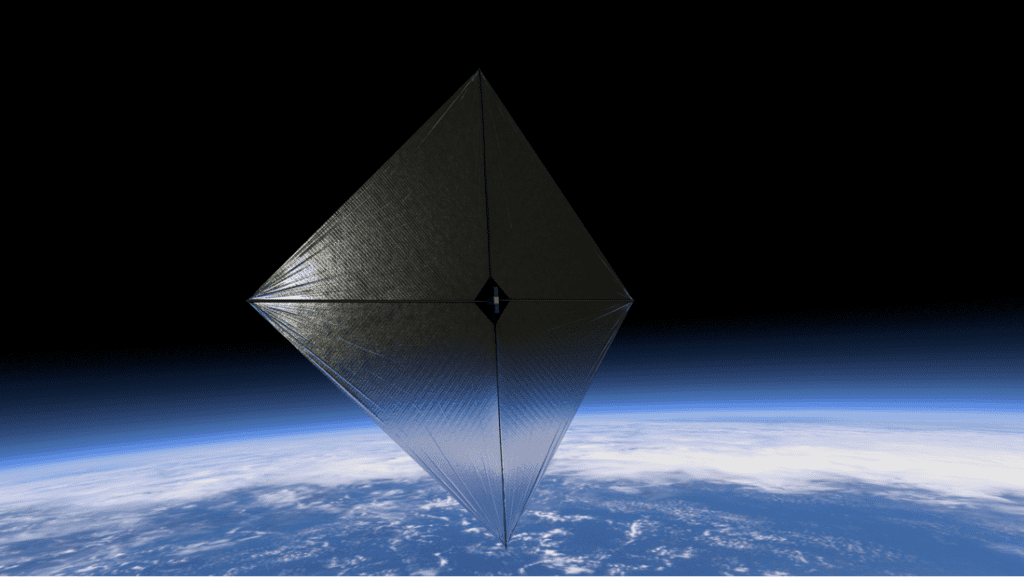Until very recently, space rockets have used a combination of liquid hydrogen and liquid oxygen to fuel their rockets. But what if I told you that using something as simple as the Sun’s rays, you could move about in space at astonishing speeds of up to 67 million mph? Enter the world of solar sails.

An American astronaut in space. Image credits: Pixabay/pexels.
Solar sailing is no longer science fiction, it’s already been used to some extent by NASA and the Japanese Aerospace Exploration Agency (JAXA). Private enterprises (most notably, a non-governmental aerospace research agency named the Planetary Society) are also working on developing the solar sail technology further. The most fascinating aspect of solar sails is that once deployed in outer space they don’t require fuel, only the pressure from solar radiation is enough to propel them across different planets.
But let’s take it step by step.
How the solar sail technology came into existence?
The idea of solar sailing in space, using radiation pressure exerted by sunlight on large mirrors to propel spacecraft, was first conceived by German mathematician Johannes Kepler in the early 17th century. In one of his letters to Galileo Galilei, Kepler proposed that just like sails on a boat are guided by the wind, one-day solar sails in space could move using sunlight instead of wind. However, he never gave a theory or performed any experiment to validate his idea.
Some 200 years later, another mathematician and physicist by the name of James Clerk Maxwell published his theory on electromagnetic radiation. According to the theory, light energy has momentum and therefore, it is able to exert pressure on objects that comes in its way, Maxwell’s findings in 1864 formed the basis of solar sailing that uses pressure from solar radiation carrying momentum. Finally, there was a working theory for solar sails.
Maxwell’s theory on light pressure was experimentally proved for the first time by Pyotr Lebedev in 1899, when Lebredev successfully measured radiation pressure using a device called torsional balance. In the years that followed, similar experiments were performed by scientists like Ernest Nicholas and Gordon Hull, during their tryouts they also successfully demonstrated pressure exerted by light due to the presence of momentum. The theory behind the idea was gaining more and more traction.
However, the original idea of powering spacecraft propulsion through sunlight pressure was only truly proposed by Russian rocket scientist Konstantin Tsiolkovsky in the 1920s. Tsiolkovsky believed that the cosmic velocity required to move an object in space could be attained by utilizing pressure from solar radiation falling on mirrors made of thin sheets.

Later, in 1925, rocket scientist Friedrich Zander published a research paper that discussed the technical aspects of solar sailing using mirrors. By the late 20s, many other scientists from different parts of the globe confirmed the possibility of using solar sails for spacecraft propulsion and the method was established as having strong potential — but no practical development took place in this field until the 1970s.
American astronomer Carl Sagan brought the matter back into the discussion, mentioning the idea of solar sailing in his college lectures and books. He even desired to launch a sunlight propulsion-based spacecraft on a course nearby Halley’s Comet, and Sagan had talked about his vision of solar sailing during some of his TV interviews as well.
Even with Sagan’s influence, solar sailing didn’t really off. It was an accident that first demonstrated the practical viability of the method.
In 1974, NASA had big problems with its Mariner 10 Probe mission. During its course towards Mercury, the Mariner probe had run out of fuel and now it was at risk of getting derailed. To keep the probe on its course, engineers at NASA came up with an interesting plan: using sunlight. In other words, they were improvising solar sailing on an already-launched mission. Mariner 10 was not designed for solar sailing but the spacecraft’s solar arrays worked surprisingly well.
NASA engineers aligned the solar panels on the probe towards the Sun and used the pressure from solar radiation to adjust the probe’s position near Mercury. The plan worked and Mariner probe 10 ended up capturing the first images of Mercury’s surface, showing just how useful solar sails can be — even when not designed for. However, this was not considered the first official solar sail space mission.
The first solar sail space mission and recent developments

The IKAROS solar sail, the first mission to prove the technique could be used to travel between planets. Image credits: Andrzej Mirecki/Wikimedia Commons
Before NASA could launch its first solar sail spacecraft mission, Japanese space agency JAXA successfully sent IKAROS to Venus in May 2010. This was the first interplanetary spacecraft that was fully powered by solar sail technology. IKAROS was equipped with solar sails made of polyimide and achieved propulsion through the sunlight-fueled photon acceleration method. The spacecraft traveled to Venus and then went towards Sun. The last time JAXA received signals from IKAROS was in 2015 before it went into a hibernation phase.
IKAROS is the first mission to truly demonstrate that solar sailing can be used to travel from planet to planet proving once and for all, beyond the shadow of a doubt, that this once-futuristic technique is now within reach
Not long after that, in November 2010, NanoSail-D2 became NASA’s first successful solar sail mission. It lasted 240 days and revealed important details regarding the use of solar sail technology in space. The mission was also aimed at analyzing the use of solar sails in eliminating non-functional satellites and debris found in orbits around the earth.
Later, the Planetary Society launched LightSail 1 on May 20, 2015, as a part of their previously announced three solar sail missions (LightSail 1,2,3). The first of the three was launched to test and demonstrate the solar sail application in space, but, it didn’t deploy at a height from the earth where it could avoid the earth’s atmospheric pressure in order to experience pressure due to solar radiation.

LightSail 2 dimensions and specifications. Image credits: The Planetary Society
The second mission LightSail 2 aboard the SpaceX Falcon Heavy was launched on June 25, 2019. When its solar sails got completely deployed in July, LightSail 2 successfully demonstrated a controlled solar sailing exercise in the lower earth orbit. In June 2020, the mission was extended until mid-2021.
In August 2021, NASA revealed that their NEA (Near-Earth Asteroid) Scout is likely to become the first interplanetary mission that will be powered using solar sail propulsion. The NEA Scout is a part of NASA’s Artemis program, which is set to launch by the end of 2021. At present, this solar sail mission can not travel with heavy machinery but it is well-equipped to carry light-weight satellites such as CubeSat.
How solar sails can change space transportation forever?

Image credits: SpaceX/pexels
The current rocket propulsion engines have limited potential due to their dependence on conventional fuel — and there’s only so much fuel you can pack in a mission. If any space agency aims for an interplanetary mission, fuel decides how far they could go. Technically, with the current propellants, we may never be able to go beyond our own galaxy — and realistically, even traveling outside our solar system seems like a huge challenge.
Moreover, at the time of a launch, rocket fuel may weigh up to 96% of the total weight of the spacecraft which leads to many restrictions that current spacecraft face. This is where solar sail can bring drastic changes in the field of space transportation. Here’s how and why solar sails could play a key role in future space missions:
- Solar sails don’t require any fuel for space travel (just for launch) — they simply run on the pressure exerted by limitless solar radiation available in our universe. Therefore, solar sails are a 100% sustainable and eco-friendly mode of space transportation.
- Solar sails may also significantly reduce the cost of space transportation. This is due to two reasons; first, spacecraft engines that use conventional fuel have a more complex design, and as compared to solar sail-based units they are made of numerous components which all together increases the expenses. Second, propellants used in modern rockets can be very costly, while sunlight is free of cost.
- With no dependence on fuel, solar sails are also considered by experts as one of the best means for interplanetary transportation. The solar sailing technique allows a small spacecraft to travel across different planets without any break. A futuristic project launched under Breakthrough Initiative called the Breakthrough Starshot aims to reach Alpha Centauri (the nearest star system to earth) in only 20 years by the means of an advanced solar sail-based propelling system. Even the most advanced modern rocket engine would take approximately 100,000 years to cover the same distance.
- Solar sails have the potential to deliver more than 90% efficiency during their operations, whereas, the current rocket propellants are able to work with only 60% efficiency.
Limitations with solar sailing in space

Image credits: murat esibatir/pexels
If solar sailing is that good then why NASA and SpaceX are still using rocket engines? Well, like every piece of technology, solar sailing is also not perfect and there are various challenges and limitations associated with solar sails.
Solar sails may prove to be cost-effective after the launch but the research work and experiments that are undertaken to create a successful solar sail setup are still costlier. Basically, the technology isn’t mature yet, and research and development are still a work in progress (and an expensive one at that). Moreover, solar sails may take lightweight satellites and small crafts to space but they are not capable of carrying heavy spacecraft and astronomers — at least with our current technology. So if you were thinking of traveling to space in a solar sail spaceship, you may need to put that idea on hold for a long long time. NASA predicts that sunlight pressure may not be effective enough to push a solar sail beyond Mars because the impact of solar radiation weakens with increasing distance from the sun. However, that’s still being debated.
Despite all these limitations, aerospace experts believe that current solar sailing technology may not be able to replace chemical rockets for now, but it will definitely increase our ability to get a closer look at various distantly located parts of space.
“The idea of solar sails has been around for about 100 years, but our structural technology has just now gotten to the point where we are ready to perform some missions using this type of propulsion,” said Hoppy Price, solar sail technology lead engineer at NASA’s Jet Propulsion Laboratory, Pasadena, Calif. “Solar sails are now being considered for interstellar travel because they don’t have to carry any fuel to operate and can be propelled by sunlight and high-powered lasers.”
It’s taken us a long time to get here, but we have functional solar sails, and researchers are constantly working on expanding their use.
Who knows where they’ll lead us next?


